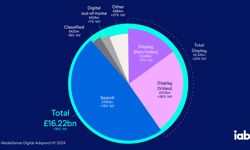
As 2023 draws to a close, everyone is thinking ahead to what is to come in 2024 and where their businesses should be focusing their efforts in the new year. Here are six resolutions that should be on your list:
1. Find your balance with AI
It’s been a hot topic in 2023. It’s had a place at every industry event, committee, and newsletter. As AI technology starts to really embed itself in our day-to-day lives, we’re guaranteed to see a plethora of new technology companies enter the industry promising us a more efficient way to run our operations.
There are some real opportunities using AI. The ability of platforms to provide data and insights to inform both campaign optimisations and the direction of travel in our businesses without the manual administration required to provide said data and insights allows us to redirect our resources elsewhere. The same can be said for our ad operations trafficking processes – there are already platforms in the market that go some way to automating creative testing, uploading and screen grabbing and that integrate with incumbent platforms. Harnessing this technology and leveraging the benefits of it gives us the opportunity not to reduce our human resource but to focus time and skills towards value added work where we’re going to grow our revenues.
However, there is a balance to be made here. Often, the areas we’ll look to automate are carried out by people in entry level roles; it’s a place that newcomers occupy and develop their early skills, learn about the advertising ecosystem, and grasp the knowledge they need so that they can start adding extra value. As leaders, we need to ensure that those opportunities remain available to continue to bring new talent into our industry, otherwise we risk a depletion in people with the skills we need to drive our businesses forward, potentially costing us more long term than what we save with automation.
2. Make your offering more sustainable
Ad Net Zero predicts that the digital advertising industry could produce over 1,000,000 tonnes of CO2 emissions in a year, highlighting that there is a long way to go for the industry to hit net zero targets. Whilst there are many steps that businesses are taking to mitigate this, there are ways that ad operations teams can affect this.
Anyone working in ad operations knows that we have substantial tech stacks feeding into our business, particularly within our programmatic supply chains. Every time an ad impression is auctioned, multiple bids are made and there is an environmental cost to each one of those bids, so consider working with a company that looks to reduce wasted bids.
Improvements don’t need to be confined to programmatic workflows either. As digital advertising evolves, we find ourselves adopting different technologies and working across a whole host of platforms. Review those platforms; do we still have a need to use this technology? Is there a piece of technology that has the function of multiple platforms that we’re working with? Streamlining the platforms that we’re using can reduce the processing power that is being used to run our advertising operations. Additionally, consider making the green credentials of potential future tech partners part of the decision-making process when considering new vendors.
3. Streamline your sites
In 2020, Google embedded Core Web Vitals into their Chrome browsers, using a Lighthouse score to indicate a measurement of page performance and the site performance speeds. This has become a measure that, amongst other elements, affects SEO ranking. The obvious steps that can be taken are by product and development teams to streamline sites, but there are opportunities to reduce this via advertising too and it’s becoming a topic of conversation between publisher ad operations teams.
Advertising on a page can contribute to the Core Web Vitals score. The ads load alongside the page content, and the larger the ad size, the more of an impact it has on your page load. This is particularly true for 3rd party creatives, where file sizes tend to be significantly higher than image files. These 3rd party tags have their creative split into two parts; an initial load, which loads alongside the site content, and a subload, which starts to load once the site content has finished loading. Tags with an excessive initial file size can considerably affect the Core Web Vitals; tests carried out by our team at Bauer Media UK have found that larger initial file sizes can affect the Core Web Vitals performance score by up to 35%, which isn’t insignificant. Furthermore, Google are ushering in a measurement change in March 2024. The First Input Delay (FID) which measures the latency of a user’s first interaction on the page, is being replaced by a metric called Interaction to Next Paint (INP). The INP measurement takes into account the latency of all user interactions on a page and will score the page performance based on the slowest interaction, which means that there is potential for the subloads to affect the score.
By working with an ad verification partner, publishers can test 3rd party ads before they end up on-site to ensure that they adhere to the specifications that work best with their properties. Improving site speeds and reducing latency by using appropriate LEAN formats and specifications not only improves SEO scores but provides a better user experience on site, cementing audience good will for premium publishers whilst not frustrating our users so much that they install an ad-blocker. Furthermore, small ad sizes are related to a small carbon footprint so this helps us work towards making our digital advertising more sustainable.
4. Revisit your processes
Once you embed a new process, product or service, how often do you revisit it to see if it’s still working for you? Digital advertising is an ever-changing industry, and that means how we work should evolve too. Chances are that a report or process you introduced five years ago to solve a problem is still in play, but the problem no longer exists thanks to advances in the platforms we use or changes in the way our commercial teams sell.
Are you working closely enough with other team across your business? You could have data that needs manual transformation to make it useful, but it takes a significant time resource; talk to your data team or insights team to see if they have a tool that can do it for you. Spending time blocking ads on commercial content? Speak with your product and development teams to work on an ad-free editorial template.
5. Upskill your team
Team structures are another important area to review and analyse whether they are working in harmony with the rest of your business. Reviewing silos that you work in is a must, and question whether these offer business continuity or whether team holidays and sickness will disrupt your service levels.
Breaking down the silos in your team is an excellent way to encourage knowledge sharing between ad operations professionals, and by doing so, not only are you ensuring that you are able to maintain service levels, but you are also helping to build your teams’ skills and knowledge. Utilise your team to train other team members; they know the platforms and processes they use every day better than anyone else and keep an easily accessible repository of the knowledge that your team holds, ensuring it is reviewed and updated regularly.
Involve your team in project work where possible and give them freedom to use their skills creatively. Your business will benefit from an ad operations team who are able to apply themselves and suggest new ways of working instead of unquestionably ploughing on with inefficient methods because that’s how it’s always been done. Additionally, this helps with succession planning as growth in skills and knowledge often gives the opportunity to promote from within and retain talent.
6. Review how you hire
There are still some businesses who require degrees (and sometimes very specific degrees) for a person to be considered for an ad operations role. Question yourself; are those coming to you with the sought-after degree always rounded in the way you’d like? By narrowing your search down in this way, you could be missing out on some brilliant minds and I would argue that a twenty-one year-old that has been in full time employment for three years could bring as much to your team as a twenty-one year-old graduate. Recruit for the skills that you need in your team; what areas must they be strong in to succeed in the role? Where does your team need fortifying? What is knowledge that can be easily taught on the job and therefore really doesn’t need to be part of your hiring process?
These practices should extend to the way you interview too. Really consider whether your interview questions are really going to help you understand the person you’re speaking with and include some practical tests that relate to the role too. If you want to hire somebody with strong analytical skills, present them with a scenario, complete with data, and ask them what conclusions they would draw from it; adding these sorts of exercises alongside learning more about the candidate should help you get a more holistic view of who you’re about to welcome into your team.
Further reading
- Ad Net Zero: UK advertising’s response to the climate emergency.
- Sustainability Is Becoming A Priority For Digital Advertising. Article by Michael Benedek.
- Sustainability initiatives and owners in digital advertising. IAB UK’s summary of digital media industry sustainability initiatives.
- Interaction to Next Paint (INP). Article by Jeremy Wagner.
This article was first published in InPublishing magazine. If you would like to be added to the free mailing list to receive the magazine, please register here.












